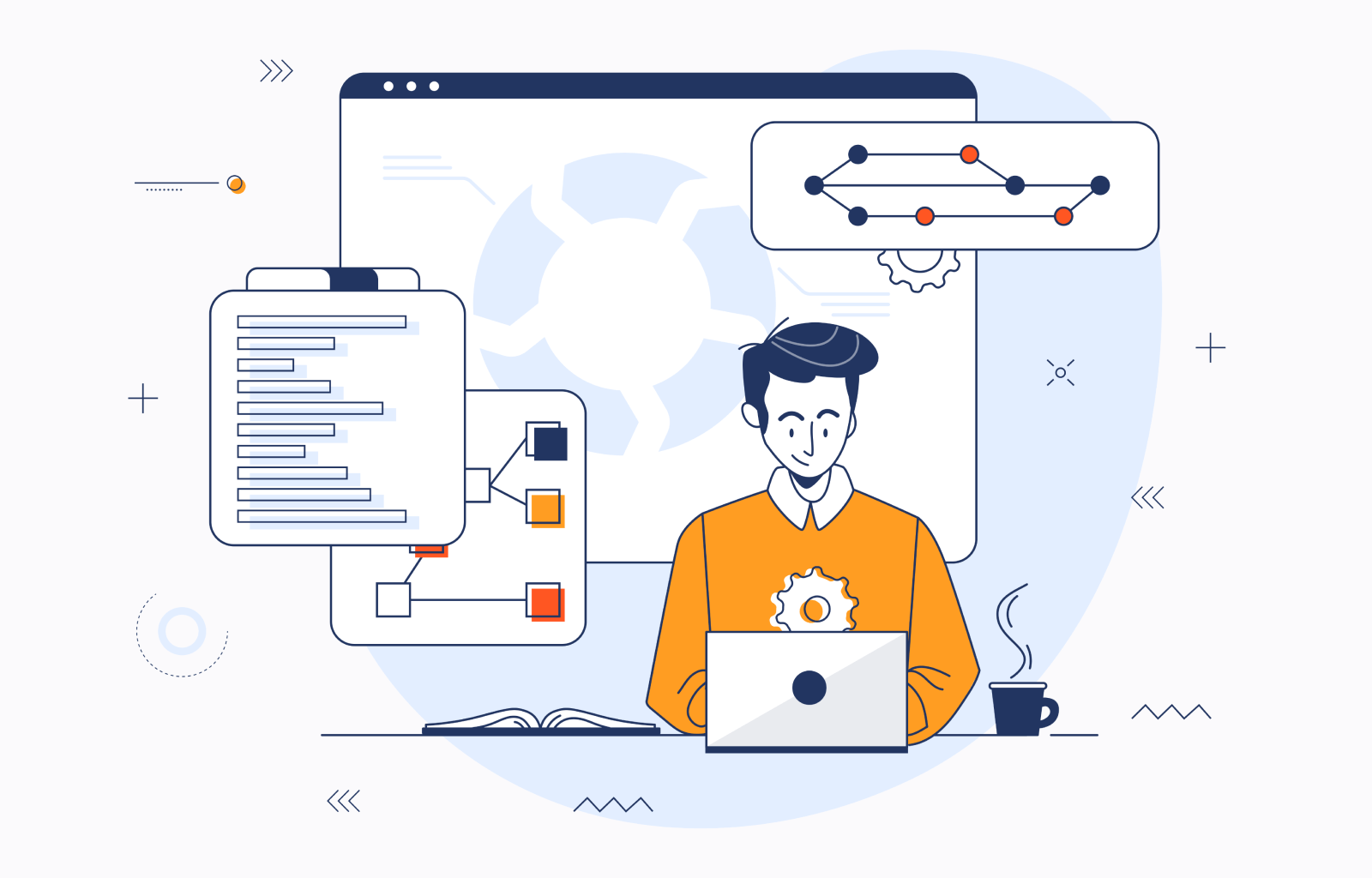How to Build a Secure Software Development Lifecycle (SSDLC)

In 2023 alone, there were 2,365 cyberattacks. This year saw a 72% increase in data breaches and an all-time record since 2021. The rise in digital threats requires organizations to prioritize security throughout all phases of the Software Development Life Cycle (SDLC). A Secure Software Development Lifecycle (SSDLC) integrates security measures at every process stage.
By embedding security practices early, teams can identify and mitigate potential vulnerabilities before they become exploitable risks. Implementing an SSDLC reduces the cost and effort of security fixes and helps protect sensitive data and business operations from possible breaches.
In this post, we'll explore the importance of a Secure SDLC, its key phases, best practices, and essential tools to ensure your software is built securely from the ground up.
What is a Secure SDLC?
A Secure SDLC is an approach that incorporates security considerations into every phase of the software development process. Unlike the traditional SDLC, where security is often an afterthought, an SSDLC emphasizes a "shift-left" approach. It addresses security concerns from the earliest stages—planning and design—rather than waiting until testing or post-production.
Why is this shift crucial? Early integration of security measures helps identify and resolve vulnerabilities before they escalate. It saves time and resources and protects the software from potential cyberattacks. By adopting a Secure SDLC, organizations can ensure that security is an integral part of the development lifecycle, resulting in more resilient software products.
Key Phases of a Secure SDLC and Best Practices
Businesses can avoid costly vulnerabilities by embedding security considerations early and consistently throughout the SDLC. Below, we break down each phase of the SDLC, discussing the security considerations, best practices, and their value for businesses.
01.Planning Phase
Planning is the foundation of the SDLC, where the goals, scope, and objectives of the project are defined. In an SSDLC, this is the stage where security requirements are identified, and a risk assessment is conducted to ensure that security is considered from the start.
Security Considerations
Risk Assessment: Performing a risk assessment helps identify potential vulnerabilities and the business impact of a breach. Risks like data leakage, unauthorized access, and compliance violations need to be evaluated early to avoid future security issues.
Security Policies: Establishing security policies and procedures, such as user authentication, authorization levels, and encryption methods, ensures that the project adheres to best security practices right from the beginning.
Best Practices
Involve Security Experts Early: Engaging security architects and specialists in the planning phase ensures that security requirements are deeply integrated into the project.
Develop a Security Plan: A detailed security plan should include risk assessments, project timelines, and security benchmarks. For example, defining threat models, incident response strategies, and security KPIs (Key Performance Indicators) ensures that the project remains on track from a security perspective.
Compliance Requirements: Adhering to legal regulations such as PCI-DSS or industry standards like ISO 27001 is crucial for businesses handling sensitive data. This avoids legal liabilities and increases customer trust.
02.Design Phase
In this phase, the system architecture and design are laid out. Incorporating security measures directly into the design ensures that software follows best practices from the architectural level down to individual system components.
Security Considerations
Threat Modeling: Threat modeling is important for mapping out potential threats and vulnerabilities for each part of the system architecture. It helps businesses identify weak points, such as insufficient input validation or insecure data flows.
Secure Design Patterns: Utilizing secure design patterns such as input validation, encryption of data at rest and in transit, and secure APIs prevents SQL injection or man-in-the-middle attacks.
Best Practices
Security Architecture Reviews: Conduct design and architecture reviews focused on identifying potential vulnerabilities in the system design. For instance, ensuring that databases have secure access layers and that microservices are isolated and protected by firewalls can reduce risk.
Secure Communication Protocols: Implementing protocols like HTTPS, TLS, and SSH ensures that data is encrypted during communication. It prevents interception or tampering.
Data Encryption: Plan for robust encryption mechanisms, such as AES-256, for data encryption, both at rest and in transit, to protect sensitive business data.
03.Development Phase
The development phase is where the software code is written. Integrating security at this stage ensures that developers follow secure coding standards. It helps to avoid vulnerabilities like injection flaws, broken authentication, and security misconfigurations.
Security Considerations
Code Vulnerability Checks: Automated security testing tools can be integrated into the development environment to detect vulnerabilities in real time. Tools such as Static Application Security Testing (SAST) help identify issues like insecure code and buffer overflows during development.
Dependency Management: Managing third-party dependencies and open-source libraries is crucial to avoid introducing known vulnerabilities into the codebase. Dependency scanning tools GitHub Dependabot can identify vulnerabilities in these components.
Best Practices
Secure Coding Guidelines: Define and enforce secure coding standards, such as OWASP’s top 10 secure coding practices. This way, you avoid common vulnerabilities like cross-site scripting (XSS) and SQL injection.
Automated Security Testing: Implement tools like SAST in your development pipelines. These tools automatically scan the code for vulnerabilities as it is being written, reducing the chance of insecure code being committed.
Code Reviews: Conduct regular code reviews, focusing on security issues, to ensure that secure coding practices are followed consistently. Peer reviews can help identify overlooked vulnerabilities.
04.Testing Phase
In the testing phase, the software undergoes rigorous testing to ensure it functions as intended. In a Secure SDLC, testing is vital in identifying vulnerabilities that could be exploited in a production environment.
Security Consideration
Penetration Testing: AI tools use machine learning to simulate advanced cyberattacks, identifying vulnerabilities faster and more accurately than traditional methods. This allows businesses to test the resilience of their software against real-world threats.
Dynamic Application Security Testing (DAST): Unlike SAST, which examines code, DAST tools simulate attacks against a running application. They test the code’s security defenses and identify runtime vulnerabilities.
Best Practices
Vulnerability Scanning: Use vulnerability scanning tools such as Nessus or OpenVAS to detect common vulnerabilities in the software before release.
Security Regression Testing: After fixing identified vulnerabilities, run regression tests to ensure the fixes do not introduce new security flaws.
Integration Testing with Security Focus: Test how different components interact securely, especially in complex systems using microservices. It ensures secure data flows and interactions.
05.Deployment Phase
An SSDLC ensures that the production environment is secure and that any security configurations and hardening measures are in place before deployment.
Security Considerations
Infrastructure Hardening: Secure the environment by turning off unnecessary services, configuring firewalls, and limiting network access. These measures minimize the attack surface of the production environment.
CI/CD Pipeline Security: Securing the Continuous Integration/Continuous Deployment (CI/CD) pipeline is essential to prevent unauthorized code from being deployed. Implementing security measures such as role-based access control (RBAC) and integrating security testing into the pipeline are critical.
Best Practices
Environment Hardening: Ensure production environments are hardened by following security benchmarks, such as those provided by CIS (Center for Internet Security). It involves securing databases, networks, and applications from unauthorized access.
Automated Security Gates: Integrate automated security gates within the CI/CD pipeline. These gates halt deployments if vulnerabilities are detected. They ensure that only secure code is pushed to production.
Access Controls: Implement role-based access controls to ensure that only authorized personnel have the ability to deploy or make changes to the production environment.
06.Maintenance/Monitoring Phase
Once the software is live, ongoing maintenance and monitoring are required to ensure continued security. New vulnerabilities may be discovered, or attackers may attempt to exploit previously unknown weaknesses.
Security Considerations
Incident Response Plans: In case of a security incident, businesses should have an incident response plan to mitigate damage, recover data, and restore services as soon as possible.
Continuous Monitoring: Implement monitoring tools to detect anomalies or potential security incidents in real-time. Tools such as SIEM (Security Information and Event Management) systems aggregate data and alert security teams to suspicious activity.
Best Practices
Vulnerability Patching: Regularly scan for vulnerabilities and apply security patches as soon as they are released. Automated patch management tools can help reduce the risk of running outdated software.
Security Audits: Perform regular security audits and compliance checks to ensure that the system continues to meet security standards.
Continuous Threat Assessment: With cyber threats constantly evolving, businesses should regularly assess and update their threat models to account for new risks.
Tools to Implement a Secure SDLC
Implementing a Secure SDLC requires the right tools to integrate security into every development phase. Here are some important tools to consider:
Static Application Security Testing (SAST)
SAST tools analyze source code or binaries for vulnerabilities without executing the code. They help identify issues like SQL injection, cross-site scripting (XSS), and buffer overflows early in the development process.
Examples: SonarQube, Fortify, Checkmarx.
Dynamic Application Security Testing (DAST)
DAST tools test running applications for vulnerabilities by simulating external attacks. They are effective in identifying issues like misconfigurations and security flaws in running web applications.
Examples: OWASP ZAP, Burp Suite, AppScan.
CI/CD Security Integration
Integrating security into the CI/CD pipeline ensures that security checks are automated and continuously performed throughout the development and deployment processes.
Examples: Jenkins with security plugins, GitLab CI/CD with security scanning, and CircleCI with orbs for security testing.
Threat Modeling Tools
Threat modeling tools help teams identify and mitigate security threats during the design phase. They provide a structured approach to evaluating the security of the system's architecture.
Examples: Microsoft Threat Modeling Tool, Threat Dragon.
Vulnerability Scanning
Vulnerability scanners identify known vulnerabilities in software components and deployment environments. They help ensure that no unpatched or vulnerable software is deployed.
Examples: Nessus, Qualys, OpenVAS.
Implement an SSDLC with Integrio
Building a Secure Software Development Lifecycle (SSDLC) is essential for mitigating the rising threat of cyberattacks. By integrating security into every development phase, you can proactively identify vulnerabilities, protect sensitive data, and ensure long-term software resilience. Implementing these practices strengthens security and reduces the cost and complexity of addressing issues later in the development process.
With over 20 years of experience in custom software development, Integrio ensures security and quality at every stage of the Software Development Lifecycle (SDLC). We specialize in addressing complex security challenges from design through deployment. Our dedicated developers provide end-to-end development services so that your software meets the highest security standards while achieving your business objectives efficiently.
Contact us to discuss implementing a Secure SDLC from the ground up.
Contact us

